A strength of the Nichols House Museum collection is Boston furniture spanning the late seventeenth century through the early twentieth century. Important furniture attributed to Thomas Seymour and Isaac Vose feature alongside chairs carved by Rose Nichols.
The following Highlights were selected for their quality and significance as examples of Boston furniture, as well as their interpretive value within the Museum. Although operating under the same basic set of rules of the day, like other regions, Boston had its own stylistic preferences, consumer trends, and economic conditions.
Scroll through to learn about Boston Colonial furniture, Neoclassical furniture, Victorian furniture, and Colonial Revival furniture in the Museum collection.
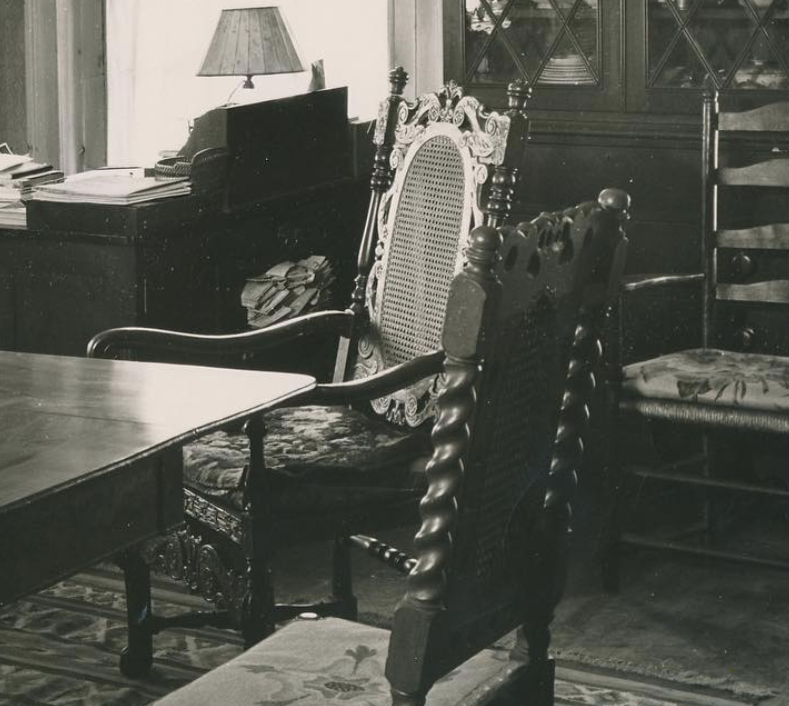
Historic photograph showing Colonial Revival chairs carved by Rose Nichols in the library at 55 Mount Vernon Street, ca. 1920. Original source unknown.
Colonial Era Furniture
Seventeenth-Century Furniture
Over the course of the seventeenth century, Boston grew rapidly. Its economy was mercantile and interconnected, and with the arrival of new immigrant craftsmen and imported English furniture, Boston kept abreast of the latest London fashions. Local craftsmen were particularly successful in producing furniture for colonists of average means. For example, this cane chair (1961.278) is made of maple whereas more expensive versions used imported walnut.
Cane chairs came into fashion in the late seventeeth-century. Although they were often imported from London, Boston dominated the North American market exporting them up and down the coast. They required the cooperation of several specialized craftsmen: joiners, turners, carvers, caners, paint-stainers, and upholsterers. Purchased in sets of six or twelve, they were stored against the wall when not in use. Cane chairs adhered to new ideas of gentility, used during new social rituals like tea drinking. Furthermore, their narrowness and delicate construction required the sitter to maintain an erect posture and polite behavior [1].
Seventeeth-century furniture was highly sought after by twentieth-century collectors for its associations with the Puritans and the “beginnings” of America.
Eighteenth-Century Furniture
The eighteenth-century was a period of immense growth and advancement in the North American colonies. The tremendous surge in population, increased wealth among the merchant class, and overall demand for goods marked a “consumer revolution” in which Boston played a leading role.
While furniture and other objects of the latest fashion were still being imported from London or being replicated by immigrant craftsmen, colonists increasingly relied upon local artisans to meet their furnishing needs [2]. In turn, these colonial cabinetmakers began to innovate on a micro-level, introducing distinct motifs and preferred construction techniques.
Among the highest quality pieces of furniture in the Nichols House Museum is a high chest of drawers (1961.369) in the late Baroque or Queen Anne style. Fashionable in the colonies from around 1720 through the 1750s, this style is characterized by its emphasis on curved lines, the interplay of solids and voids, and restrained ornamentation. While the Nichols House Museum has other examples of this style in its collection, this walnut high chest is a work of master craftsmanship. Note the refined sophistication of the cabriole legs which terminate in pad feet, the broken arch pediment, and the concave fan on the center bottom drawer. Although its maker is unidentified, various construction and design elements, as well as its ownership history, reveal it to be produced in or around Boston.
Rose Nichols purchased this chest in 1939 from a Beacon Hill antique dealer who had consigned it from Mary Cabot Wheelwright. Rose Nichols and Mary Cabot Wheelwright had much in common: both women grew up on Beacon Hill, did not get married, pursued careers, and even established museums. Wheelwright founded what is now known as the Wheelwright Museum of the American Indian, located in Sante Fe, New Mexico.
The Cabot family of Boston acquired wealth in the eighteenth century through the shipping and trading of fur, opium, and human beings. That wealth purchased this chest, making it one of many objects in the Nichols House Museum with ties to slavery (mahogany was felled by enslaved people in the West Indies, for example). According to Wheelwright, the chest had been passed down from one generation to the next.
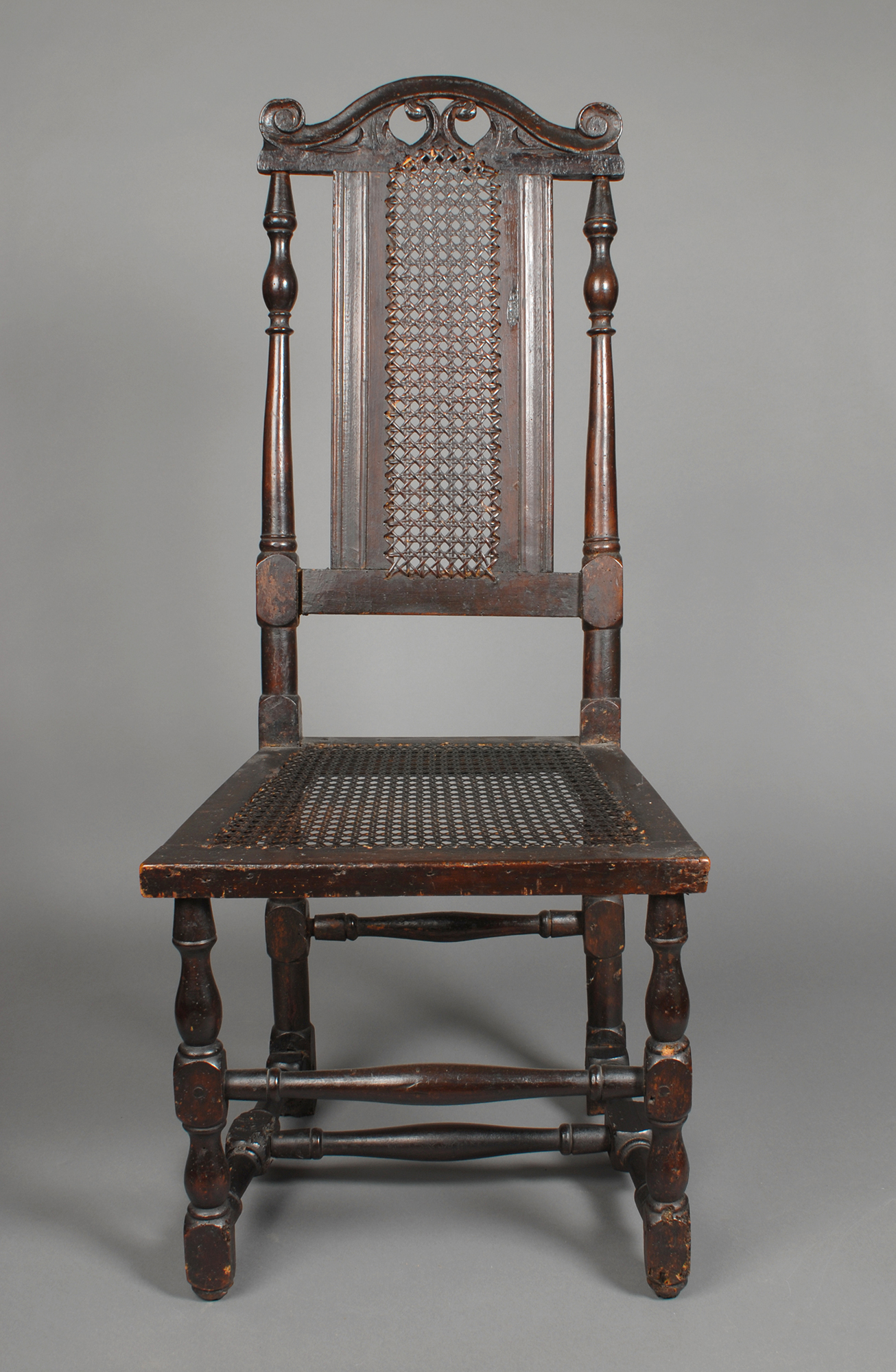
Caned side chair, Boston, Massachusetts, late 17th century. Maple. Nichols House Museum collection, 1961.278.
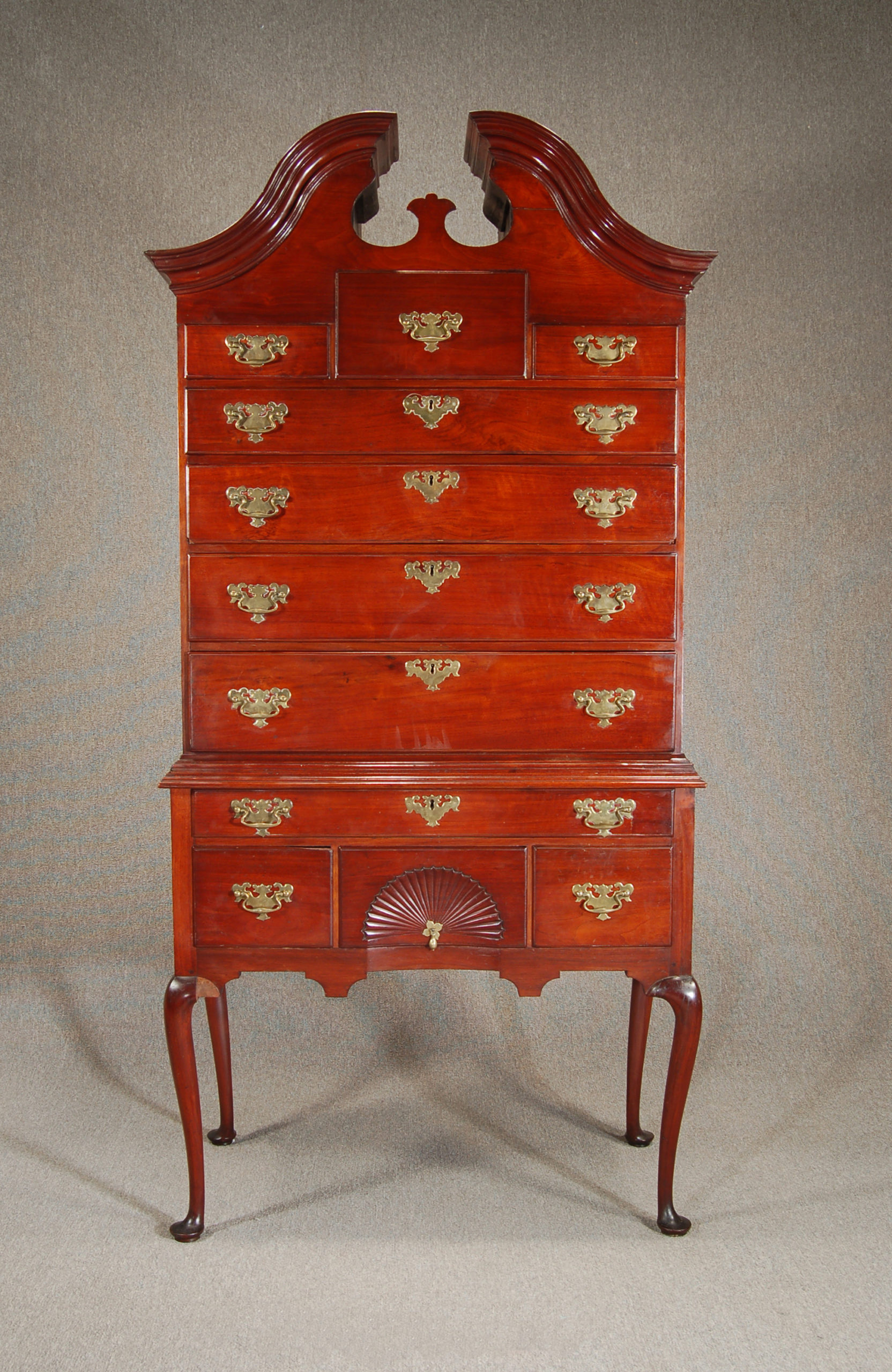
Chest of drawers, Eastern Massachusetts, ca. 1745. Walnut with brass pulls. Nichols House Museum collection, ca. 1961.396.
Neoclassical Furniture
The Nichols House Museum collection is especially strong in early nineteenth-century Boston furniture. Examples include a pier table attributed to Thomas Seymour and John Penniman, a card table also attributed to Seymour, and a French secretary attributed to the workshop of Isaac Vose & Son.
Neoclassical styles became popular in the United States after the Revolutionary War and remained in fashion into the nineteenth century. Inspired by excavations at Herculaneum (1738) and Pompeii (1748), neoclassicism was adopted internationally, resulting in varying design vocabularies that reflected each country’s civic ideals. In the new United States, the early classical revival style became synonymous with democratic politics, hence its more colloquial term, Federal. This style emphasizes rectilinear shapes with balanced, slender proportions and ornamentation through the use of inlay, paint, and relief carving.
This pier table (1961.11) is significant, not only in the Nichols House Museum collection, but in the study of Boston furniture at large. Attributed to the shop of Thomas Seymour (1771-1848) and bearing the inscription “Painted in M___ 1809 by John P___niman,” it is the only piece of furniture signed and dated by John Penniman (1782/83-1841), Boston’s most important decorative painter of the federal period. Further, it is the only Boston example of a pier table painted and gilded in what was then referred to as the “antique taste.” The ornament is based on two plates in Thomas Sheraton’s influential publication, The Cabinet-Maker and Upholsterer’s Drawing Book (1793), which in turn borrowed from Robert Adam’s designs. Still, the overall form and adaptation of these published designs demonstrate both Seymour and Penniman’s proclivity toward innovation and experimentation [3]. While painted and gilded case furniture was extraordinarily popular in New York, Philadelphia, and Baltimore, in Boston the enthusiasm for the fashion was contained to the importation of fancy-painted chairs [4]. Also owing in part to the paucity of furniture decorators in Boston, this pier table is extremely rare. While it was likely purchased by Rose Nichols during or after the 1930s, there is no documented evidence as to how the table came into the collection. The discovery of Penniman’s signature in 2010 by furniture conservator and historian Robert Mussey has allowed other pieces of Boston painted and gilded furniture to be attributed to him.
In the early nineteenth century, there was a shift toward quantity in manufacturing that distanced craftsman from consumer and signaled a burgeoning industrial revolution. More often than not, this resulted in economic hardships for individual craftsmen such as Thomas Seymour.
English immigrant Thomas Seymour and his father John Seymour were the leading proponents of the Federal style in New England. In 1804, Thomas Seymour opened the Boston Furniture Warehouse where he advertised an inventory of “every article necessary to furnish a house complete” [5]. No longer were craftsmen creating bespoke furnishings for clientele with whom they had long-standing relationships, as was done in the eighteenth century. Instead, customers visited auctions or warehouses such as Seymour’s where they purchased objects already made [6]. Entrepreneurs such as Seymour employed many journeymen and apprentices and relied on a division of labor for commercial success.
In 1817, the wartime economy forced Thomas Seymour to close his own shop. Seymour soon found work with cabinetmaker James Barker. The contemporary economic climate and pressures on Barker resulted in furniture that was not up to Seymour’s previous standard. Although there is no supporting documentation, this card table (1961.149) attributed to Thomas Seymour was likely produced under the auspices of the James Barker shop [7]. The balanced proportions, fluted column supports, lion-mask hardware, and figured maple veneering are typical for the period. Although it is perhaps not the apogee of Seymour’s talents, it remains a fine piece of Boston-made furniture and a highlight within the Museum’s collection.
In the same year, Seymour began working for Isaac Vose & Son, a highly successful firm in what is today Boston’s South End. With an increase in auctions, warerooms, and expanding marketplaces, skilled craftsmen like Seymour found themselves reduced to wage laborers. Isaac Vose Sr. (1767-1823), produced a great deal of Boston’s finest late classical revival furniture. Often called Empire for its association with Napoleon, this second iteration of neoclassicism attempted greater accuracy in reproducing ancient Greek and Roman forms. Furniture in the late classical revival, or Empire, style is often referred to as monumental due to its large volume. Glossy veneers using exotic woods, gilding, and ormolu (gold-coated brass) account for materials and ornament.
Vose’s furniture appealed to the elegant but restrained tastes of Bostonians and could be found in the homes of the city’s wealthiest families, including Mrs. David Sears (née Miriam Clarke Mason; 1788-1870), the daughter of Jonathan Mason. Jonathan Mason was the principal developer of Beacon Hill and original owner of 55 Mount Vernon Street, now the Nichols House Museum. The French secretary (1961.462) in the Nichols House Museum collection is attributed to Thomas Seymour as a foreman for Isaac Vose & Son, ca. 1820-1824. The bookmatched mahogany veneering, sizable turned columns with ormolu capitals and plinths, and overall solidity of this French secretary make it a high style example of Empire furniture.
The secretary is said to have been a gift to the Nichols family from Mrs. Horace Gray (née Jane Matthews), daughter of Supreme Court Justice Stanley Matthews (in office 1881-1889; b.1824-1889) and wife of Supreme Court Justice Horace Gray (in office 1881-1902; b. 1828-1902). The Nichols’ relationship to the Grays is unknown at this time.
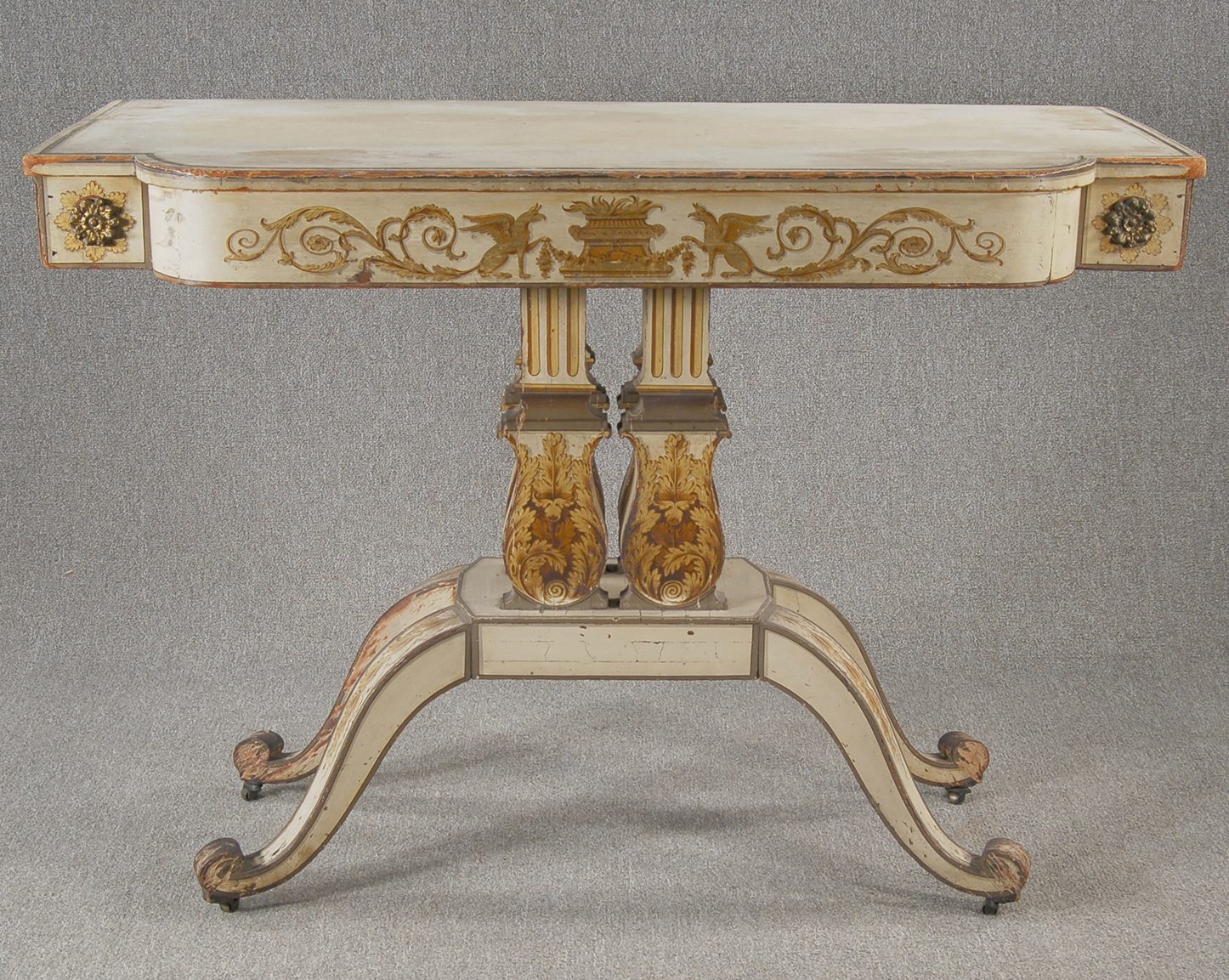
Pier table attributed to Thomas Seymour with decoration by John Penniman, Boston, Massachusetts, 1809. White pine and white ash; brass mounts. Nichols House Museum collection, 1961.11.
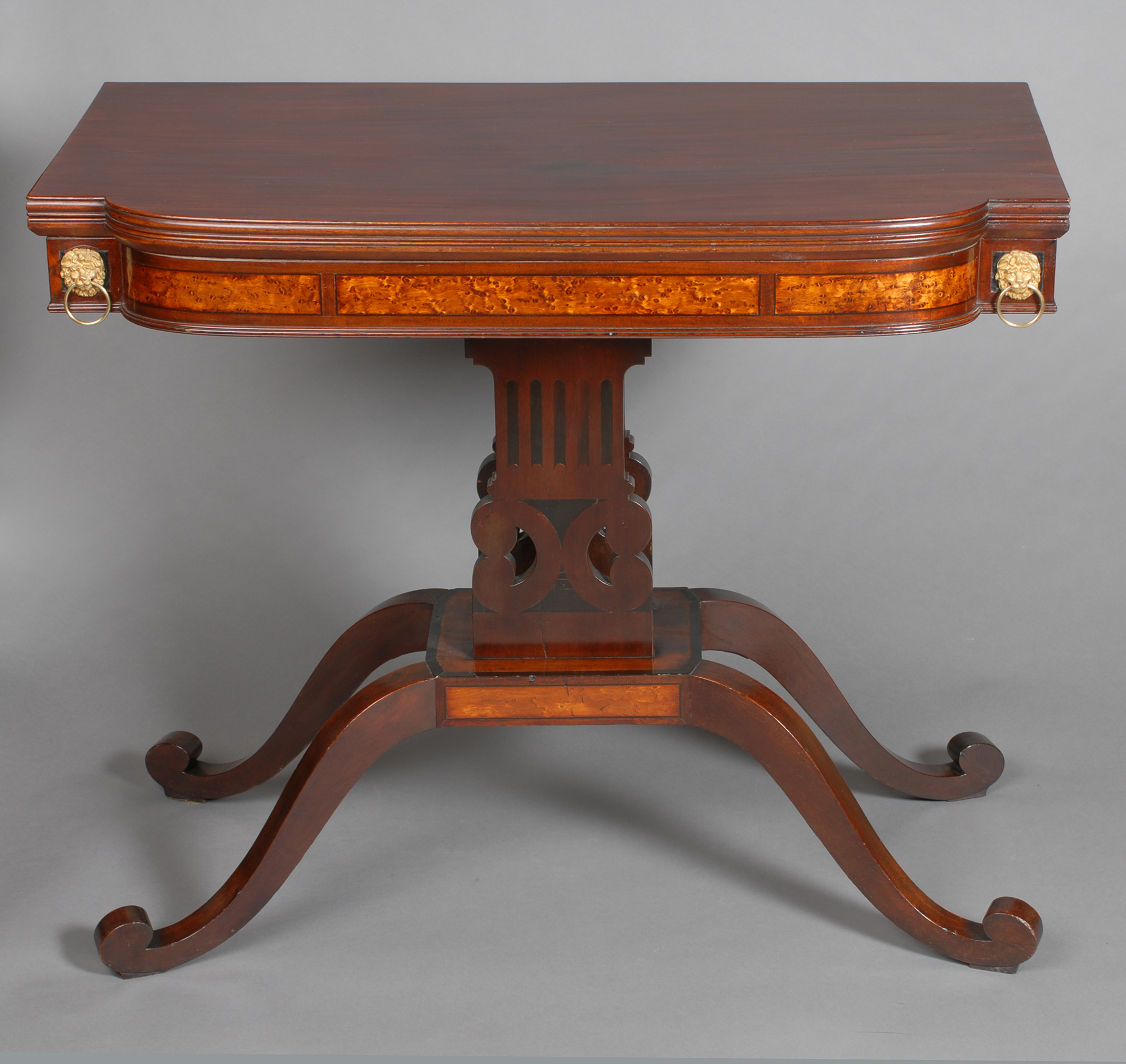
Card table, attributed to Thomas Seymour, probably working as a foreman for James Barker, Boston, 1817-19. Mahogany, white pine, ash, brass. Nichols House Museum collection, 1961.149.
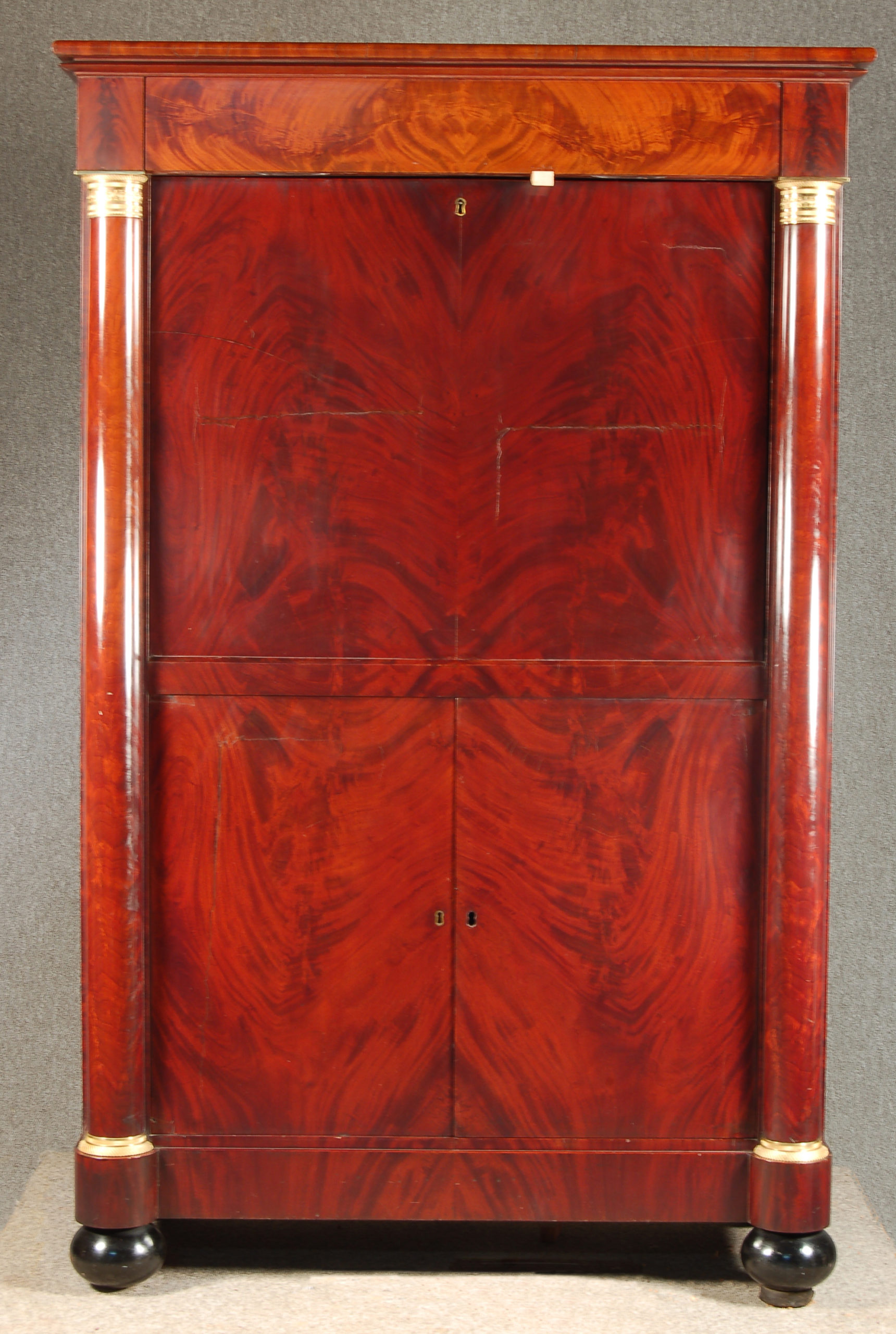
French secretary, attributed to Isaac Vose & Son, 1820-24. Mahogany, Honduras mahogany, ebonized maple, white pine, poplar, brass, wood baize (replacement). Nichols House Museum collection, 1961.462.
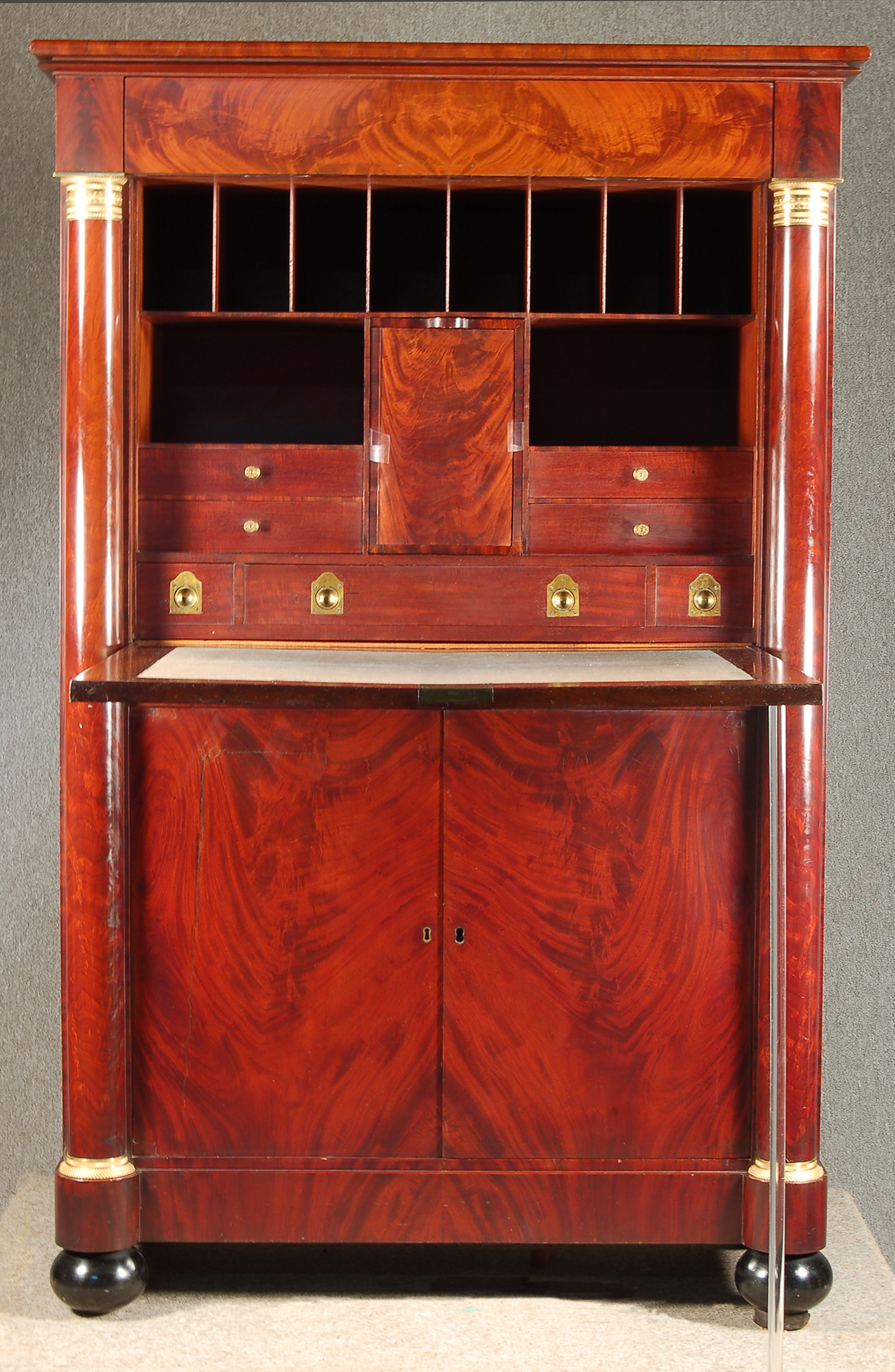
French secretary, showing interior cabinets.
Victorian Furniture
While the Neoclassicism of the early nineteenth century was defined by clean lines and cool rationality, the mid-nineteenth century embraced Romanticism and emotion. One revival style followed another—Greek Revival, Gothic Revival, Egyptian Revival, Rococo Revival, Renaissance Revival, and Colonial Revival—each offering its own subjective and dramatic appeal to a “nobler” past amid a tumultuous present. Societal factors such as immigration, urbanization, and the Civil War led many affluent Americans to become preoccupied with the grandeur of history and times gone by.
New technologies increased not only production but also the dissemination of information, including design ideas and advertisements for the latest fashions. Industrialization also established a new middle class with increased purchasing power while increasing the disparity between rich and poor.
By the 1840s, a new cultural elite emerged in Boston. This class saw themselves as enlightened and urbane, and they engaged in burgeoning civic philanthropy, founding cultural institutions and charitable organizations.
New furniture forms came into being while medieval forms were repopularized. For example, sideboards, which had been in use since the fifteenth century, imbued the dining room with theatricality [8].
At mid-century, sideboards took on a massive scale and often boasted lavish carving and exotic woods, reflecting both societal prosperity and the owner’s individual wealth. The black walnut Renaissance Revival sideboard (1961.209) in the Nichols House Museum collection features a dramatic grapevine crest rail with Bacchus at the center. It was purchased at auction by Elizabeth Nichols in 1869 and she described it as “nicely finished with excellent carving.”
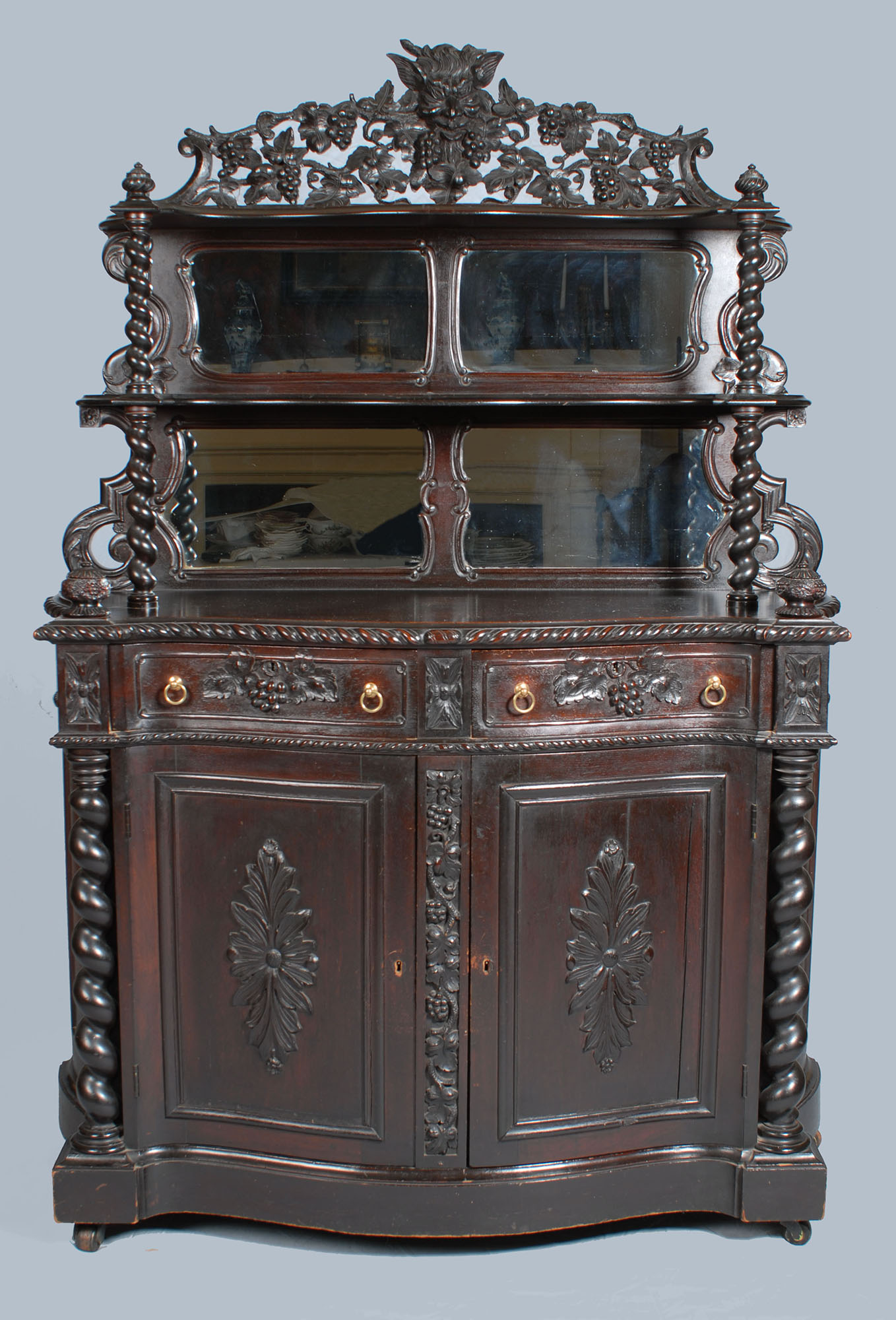
Sideboard, American, ca. 1860. Black walnut. Nichols House Museum collection, 1961.209.
Colonial Revival Furniture
Not necessarily a movement, the Colonial Revival represented a widespread nostalgia for a highly romanticized interpretation of America’s Colonial period. Although in some ways a rejection of modernity, the Colonial Revival, which lasted through the 1930s, was paradoxically a modern invention. It especially resonated in New England where many inhabitants touted Puritan ancestry. Many of the aforementioned highlights, such as the Queen Anne chest of drawers, were collected by Rose Nichols or her family with these sentiments in mind.
Yankee women played an important role in cultivating and stewarding the ideology around the Colonial Revival. Rose Nichols wrote articles for women’s magazines advising on period furnishings that denoted “good taste” and in an interview for the Boston Sunday Advertiser, Margaret remarked that “in former days people made simple things with simple tools.” In the early twentieth century, Margaret Nichols opened a Colonial reproduction furniture business, Pegleggers.
The Colonial Revival was also commodified and commercialized, lucrative not only for larger companies or antiquarian entrepreneurs like Wallace Nutting but also for immigrant craftsmen who likewise successfully marketed reproduction Colonial furniture to middle-class buyers. Regardless of who produced the furniture, Colonial styles became synonymous with American values.
Many of the Museum’s reproduction pieces were produced by the Boston-based company Irving & Casson. The chair shown right (1961.370) was made by Irving & Casson-A.H. Davenport Co. (Irving & Casson merged with A.H. Davenport Co. in 1914) and copies a Chippendale design popular in Boston in the mid-eighteenth century (see 1961.210).
Coinciding with the Colonial Revival, the Arts and Crafts Movement also looked to the past for inspiration. International in scope, the Arts and Crafts Movement condemned mass production and the dehumanizing effects of factory work. Quality design and democratized handcraftsmanship were seen as a solution to societal ills and its precepts applied to other areas of reform such as labor and women’s rights, as well as political currents like socialism. With its emphasis on education and literary production, Boston and New England served as the intellectual hub of the Movement in the United States and its artists were perhaps the most successful in exacting its ideas, especially honoring the craft traditions of the past [9].
In Boston and New England, the Colonial Revival and the Arts and Crafts Movement were often intertwined. No better example of this can be found than in a set of seventeenth-century style chairs with carvings attributed to Rose Nichols (1961.100.1-2). In 1906, Rose custom ordered the chairs from Irving & Casson asking that they be left uncarved so that she could execute the relief carving herself. These chairs copy a seventeenth-century English chair (1961.279a) in the collection that features the popular “boyes and crown” motif. In carving the chairs, Rose exercised Arts and Crafts principles of handcraftsmanship to achieve a Colonial aesthetic (English caned chairs were a popular import in seventeeth-century Boston).
Like the Colonial Revival, the Arts and Crafts emphasis on the well-designed home was an entryway for women’s participation in the Movement. “Have nothing in your house which you do not know to be useful or believe beautiful,” stated British theorist William Morris. However, furniture making was not always seen as an appropriate activity for women because it was perceived as requiring physical strength. Thus, for women proponents like Rose and Margaret Nichols, the Colonial Revival and the Arts and Crafts Movement were as much about the future as they were the past.
Laura Cunningham
Curator of Collections and Education
April 2020
[1] Lasser, Ethan. “The Cane Chair and its Sitter.” In American Furniture, edited by Luke Beckerdite. Chipstone Foundation: 2010.
[2] Gadsden, Nonie. “Arts of the Colonial Americas: The Eighteenth Century.” In MFA Highlights: American Decorative Arts. MFA Publications: 2006.
[3] Mussey, Robert and Christopher Shelton. “John Penniman and the Ornamental Painting Tradition in Federal-Era Boston.” In American Furniture, edited by Luke Beckerdite. Chipstone Foundation: 2010.
[4] Ibid.
[5] Mussey, Robert and Clarke Pearce. Rather Elegant than Showy: The Classical Furniture of Isaac Vose. David R. Godine, Publisher: 2018.
[6] Ibid.
[7] Ibid.
[8] L’Ecuyer, Kelly. “Revivalism and Eclecticism: The Mid- and Late Nineteenth Century.” In MFA Highlights: American Decorative Arts. MFA Publications: 2006.
[9] Gadsden, Nonie. “Reaction and Reform: The Late Nineteenth and Early Twentieth Centuries.” In MFA Highlights: American Decorative Arts. MFA Publications: 2006.
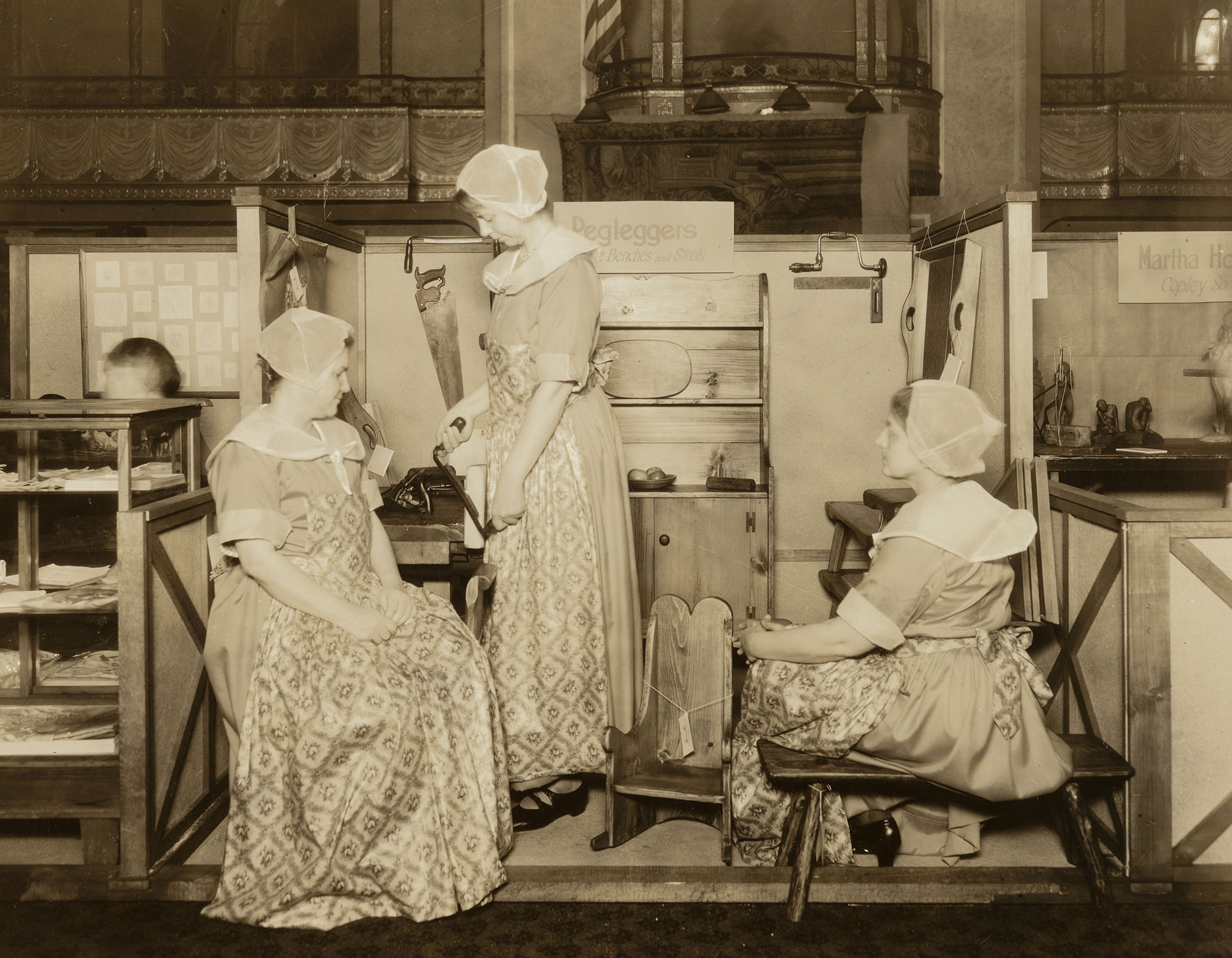
Margaret Nichols (standing), Theodora Jones, and Charlotte Ware in Colonial dress at a Pegleggers exhibit, ca. 1930.
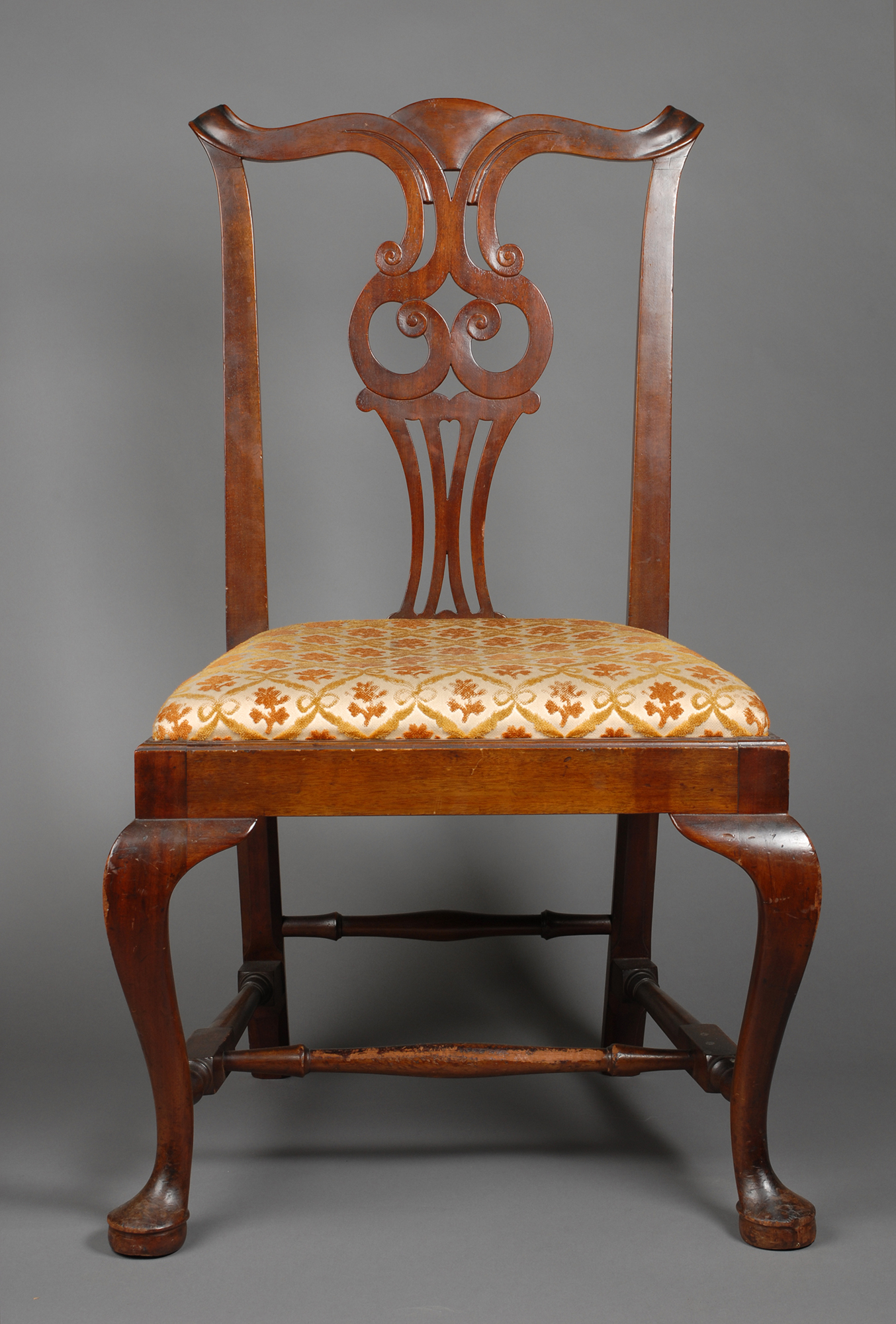
Side chair made by Irving & Casson-A.H. Davenport Co., early 20th century. Mahogany. Nichols House Museum collection, 1961.370.
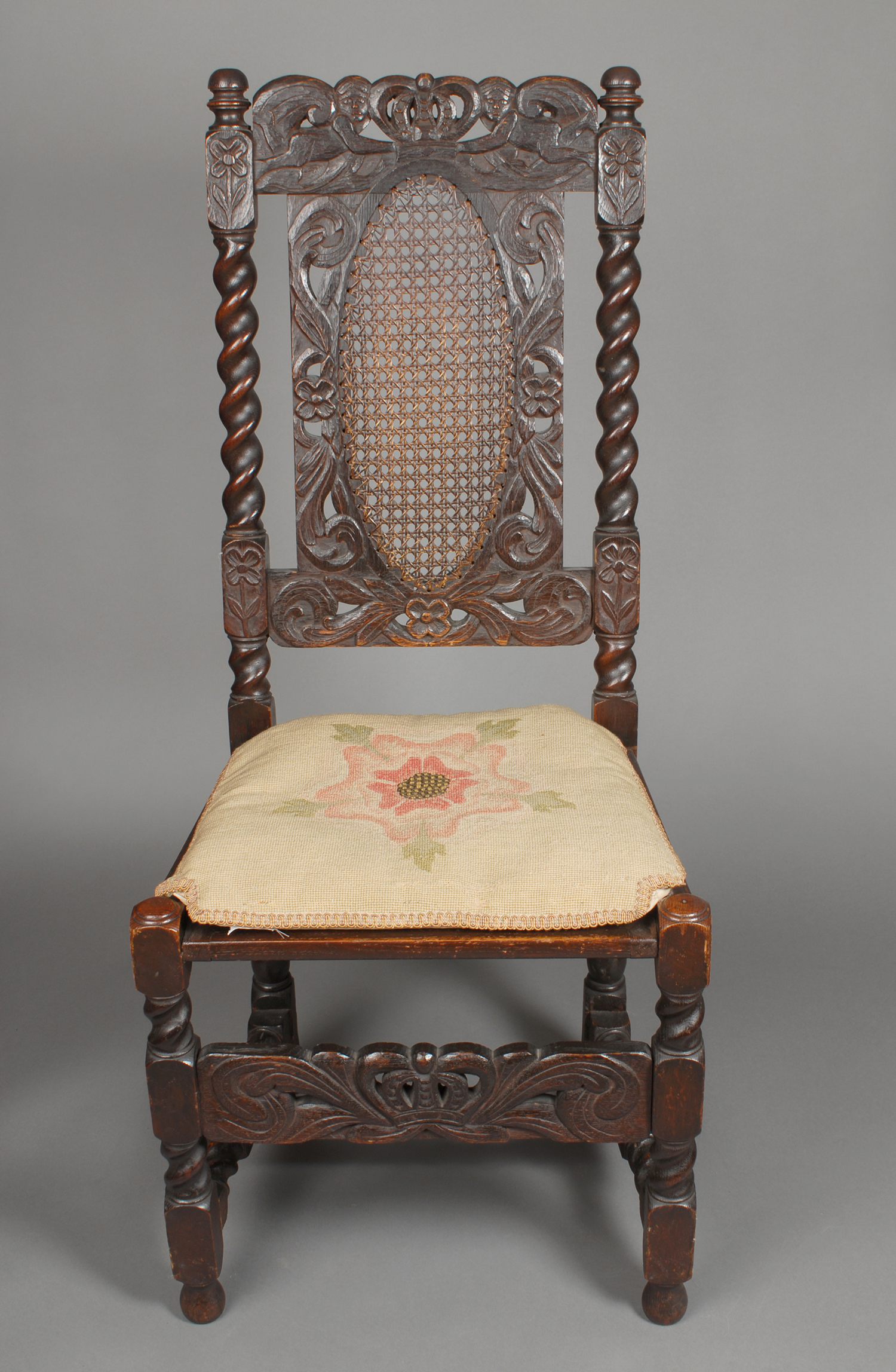
Side chair attributed to Rose Standish Nichols, 1906. Oak and caning. Nichols House Museum collection, 1961.100.
